- The Pain-Free Movement Protocol
- Posts
- Low Back Pain is Wreaking Havoc on Your Productivity...
Low Back Pain is Wreaking Havoc on Your Productivity...
Here's How You Can Fix It
Lower back pain is debilitating. It freakin’ sucks. And it’s one of those chronic pains that truly affects you everywhere you go.
The thing that’s worst about lower back pain is that, unlike knee pain or anything below the belt, it doesn’t get any better when you sit down… It Gets Worse.
If you find yourself sitting down for long periods of time either:
At a desk all day for work
During your commute to work
Couple hours at a time during work meetings
At home playing video games
At home on the couch with the family
Then, as a rule, your lower back is going to be more prone to shortening, tightening, and weakening of the muscles and connective tissues surrounding your lower back; this is the reason your back hurts so damn much.
Now, if you’re lucky, lower back pain only bothers you some days; in spurts. Some days you wake up feeling like a normal human being, and others… well, they just aren’t as productive, are they?
Maybe you suffer tremendously from low back pain, and nearly every thought throughout the day is muddied by chronic pain pain. How can you be productive when pain follows you everywhere you go?
Either way, if back pain is your normal, or an unpleasant guest that stays too long for comfort before leaving, promising to revisit…
The following is a foolproof method of attacking lower back pain.
THE SOLUTION
The solution is to rebalance and rebuild your muscles and connective tissues (Cartilage, ligaments, fascia, tendons) from the “Ground, Up”

This what I picture when I think “Ground, Up". Meadows being the first stage of developing a forest, etc. etc. It’s also just pretty!
What do I mean by from the ground, up? What I mean is we have to use common sense and consider the entire kinetic chain above and below the pain, not just the problem area itself.
Here’s 2 examples (and I’ll get into more detail shortly),
If your back hurts when you sit for 5 hours at a time, but ALSO hurts when bash your heels into the ground when you miss that last stair in the morning as you zombie your way to the coffee machine… Well, there’s something wrong with the kinetic chain BELOW the problem area.
Similarly, if your back hurts while sitting, but it also hurts when you reach overhead to change the lightbulb… Well, there’s something with the kinetic chain ABOVE the problem.
So now that’s understood, mildly at minimum, I think we’re ready to get into the exercises!
THE SOLUTION (FOR REAL THIS TIME)
So, as long as you’re ok with reading a massive article… In this section I intend to give a list of exercises I like to program for my clients in order, from the “ground, up” in terms of the area of the body they affect.
I intend to also give good, evidence-based reasoning and real world application as to how and why they are so damn effective at solving lower back pain!
What I DO NOT intend to do here in this article, is explain, in detail, every step and detail of how to perform the exercises I list out. This really isn’t the best place for that. Video explanation is a much better platform for dishing out details with visuals, etc.
(Also… can’t expect me to give out ALL my secrets for free, can you?)
Here we go!

I just imagine this being the face of all my readers as I drone on into the details, but I’m told that details are what my last article lacked!
Step 1 - Backwards Walking

There are soooo many ways to do this but they ALL rock.
With a GAZILLION options for getting after backwards walking, and a jillion creative tools employed by folks all across this flat earth (😉), this exercise is good as it gets for developing and rebalancing foot health, calf health, knee health, quad health, and building a foundation of balance and strength on top of which we will construct the strongest, most mobile, pain-free back of all time.
Because this exercise PUSHES with the toes, opposite to normal walking where we flop our toes down after a heel strike, we start to develop balanced strength across the lower body, starting with the toes, all the way up to the back.
I don’t really care how you do this exercise. You can pull a car on a rope with your teeth, or put your back against a dumpster and push it up and down that New York alley way, or you can walk backward on treadmill. Doesn’t matter, as long as you get a burn, and you reach the foot behind you as far as you can with each step without losing stride.
(GAH. I literally just told you I wasn’t going to form coach/explain… You can take the trainer out of the boy, but you can’t… no, wait. Bad example. Edit that out.)
I had a client who LITERALLY couldn’t even move her toes. It was sooooo crazy. Wiggle your toes right now. Pretty easy, huh? Well after millenia of sitting down and walking in comfy, thick soled shoes like a normal human, she developed SEVERE imbalance, stemming from her feet!
After a few weeks of backwards walking (among other exercises) in thinner shoes, and yes she experienced some pain and discomfort throughout the process, her feet unlocked. And for once in her adult life, her chronic pain started to subside!
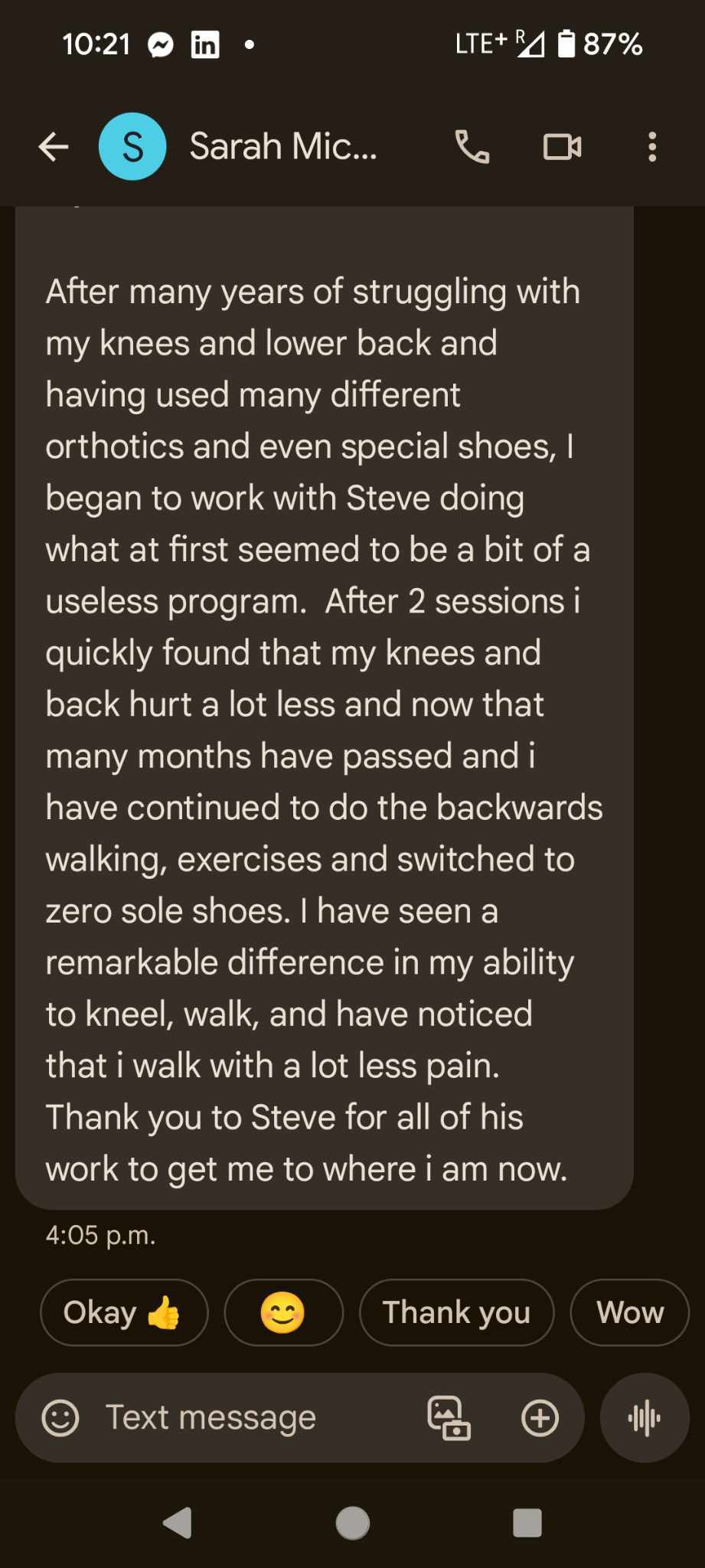
She’s such a sweetheart !
Step 2 - Full Knee Bend
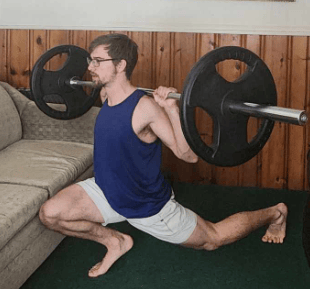
No. You don’t have to hoist 135 lbs like so. But you can imagine how impossible this would be without “Ground, Up” Development!
Can you fully bend your knee?
I mean. Can you FULLY bend your knee? Like 100% all the way, won’t go any further because the calf and hamstring are mashed together like tectonic plates.
If the answer is yes, then fantastic - Move to the next step!
If the answer is no, then here’s how to get there, briefly, and why it’s important.
First and foremost… DO NOT WORK THROUGH PAIN. If you bend your knee and feel pain at any % of the way down, just stop there. Work within your comfortable range, and your body WILL, with the help of targeted exercises, open up the doors to more range over time.
Pain is a defense mechanism to prevent you from destroying something internal. Listen to it, and don’t push past 4/10 pain whenever possible.
Now, if you need specific exercises because you do not know how to increase your knee bending capabilities, then I can help. I just don’t want to bog this article down any more than it is. DM me on any social media or book a free call and lets chat:
https://calendly.com/dynamicfreedomfitness/quick-call-w-parkour-steve
Why is it important for back pain to be able to fully bend the knee?

Fully bending the knee unlocks access to the lower back that are otherwise cut off!
If you can’t fully bend your knee, your everyday kinetic chain use is skewed. As in, your steps down the stairs or up hill or in general are going to be wacky and affecting your lower back in ways you aren’t necessarily aware.
Also, to put it simply, when was the last time you FULLY squatted down? When you were a kid? Last week? I ask because the feeling of stretch and pull on the lower back when fully squatting is GORGEOUS.
And you just don’t have access without fully bending the knee.

Back pain wasn’t the goal, but once he unlocked his knees, his back pain subsided, and his productivity shot up through the roof!
Step 3 - Hamstrings

Goofy Photo Alert!
My shin bones bounced off my forehead after failing a flip on the trampoline🤣
Can you touch your toes? Have you ever deadlifted? Have you ever isolated you hamstrings with exercises at all… ever?
Hamstrings have a DIRECT relation with the lower back. Don’t believe me? Sit down on the floor with your legs straight, feet together. Now sit up perfectly straight. I mean, make a 90 degree angle with relation to your back and femurs.
If you cannot do this, like I could not for a decade, then try it again after stretching your hammies for a few minutes. Then try it again. It’ll be easier to sit up straight without rounding your back like crazy.
(If you don’t know how to stretch your hammies to great effect, I hold all the secrets for how to unlock hammies in a short time frame)
Lots to go into with Hammy strength and length, but heres a list of exercises I use to great effect:
Straight leg romanian deadlifts

Dangerous at high weights, but unbelievable for developing hammy ability.
Jefferson Curls

I would NEVER have been able to do this without slow progressions, but my back is undefeatable thanks to strong and long hammies.
Elephant walks

SO good for unlocking hamstring action.
etc. There’s more, but there’s also more to cover!
If you unlock your hammies, like with fully knee bending, you’ll unlock your back in ways that have been cut off for too long. Balance comes from the ground-up folks!
Step 4 - Glutes and Surrounding Hip Area
You simply cannot bend your hips and maintain a straight back with tight glutes.

There are dozens of ways to unlock your hips and glutes, but these are the best ways I know:
Stretching and strengthening the piriformis and glute medius - Elevated Pigeon Pose
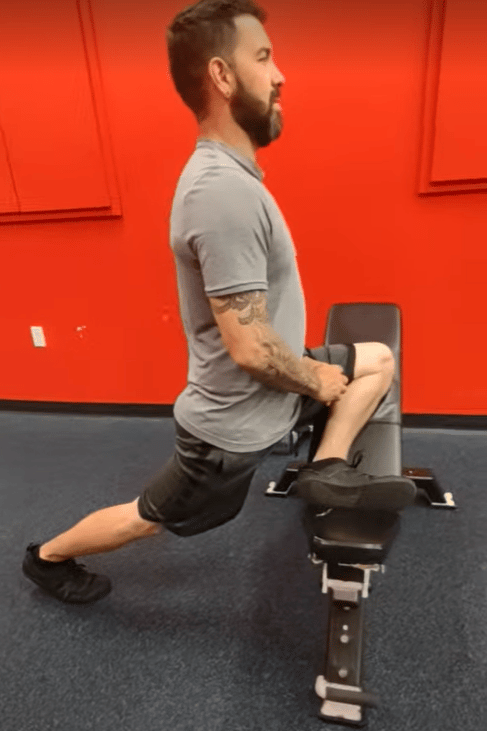
This unlocks use of the hip much like how a baby can chew on his toes… Try doing that now and your back would fall off.
Building strength in the inner thighs and also lengthening the glute maximus - Seated Good Morning

I’m just reusing pictures 😆 Please forgive me.
Unlocking the hips provides unparalleled hinging ability. Think about that. A world where you could hinge 100% at the hips to pick something up off the ground. Your legs locked , your back would be perfectly straight, chest touching knees, and you could pick up a toothpick off the ground with your elbows. Of course hammy flexibility and a wild resolve would come into effect too…
But essentially, if you CAN hinge at the hips, your no longer NEED to round the back all the time. And that is important for back pain reduction.
Step 5 - Lateral “Core” Area

Ughh… The what now?? I don’t speak Latin…
The lower back is a… complicated mash-up of muscles. A lot of the time it’s stiffness that’s the problem, but some folks have a history of sports or changing a lightbulb with 1 side that needs a harder balancing routine.
Lets start with the lateral aspects of low back development.
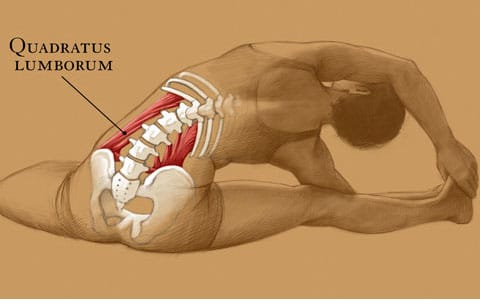
Look at the increased reach with a flexible QL!
If we can develop increased lateral range, we can unlock SO MUCH ability in our hips and back. Notice how the QL connects to the ribs and the hip, respectively.
The great thing about this area is that we can unilaterally (one side at a time) rebalance our lower back and unlock huge potential for comfort and ability.

This dude is freakin’ SHREDDED, my gosh.
Side crunches. Twisting sit ups. You know… those exercises we all love?
Those help develop the obliques with in turn increase our ability to move and resist in a twisting, lateral motion. There are SO many different oblique exercises, so I won’t get into it here, but it’s important to understand the key roll the lateral core plays in the lower back.
Think about reaching down to pick up a pencil by your left foot.
Your left hand is holding, say, a 35 lb dumbbell, or purse with a 35 lb dumbbell in it.
So you reach down to grab it with the right hand.
The knees likely bent because your hammies ain’t so flexible yet.
This puts ALL the stress of the bending, crossing, twisting motion on the low back.
And what do you know, since you’ve never targeted the QL or Obliques in your life…
You throw your back out reaching for a pencil…
It’s more than just developing STRENGTH in these areas, though. Strength is only effective within the range that you built the muscles and connective tissues to be strong.
Imagine it like a sea wall meant to block the tide and waves from drowning a village. If you only build the sea wall half as high as is needed, the water gonna wash the village.
Now imagine you built strength in your obliques but only in the short range that allows you to touch your knee… Well, if you reach below your knee… OUCH. Thus ends the analogy.
We need to develop strength at a continuously progressing range of motion to prevent injury and to build a balanced and strong body that is pain-free and productive.
Step 6 - Upper Back and Neck
Like how I mentioned 300 years ago at the top of this article… sheesh, I may have bitten off more than I was supposed to chew here… The lower back could be affected by movements above the trouble area in the kinetic chain.
Areas like the Trap-3 are important factors in the lower back pain equation.
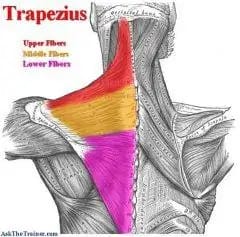
The lower, purple area is the “trap-3” section of this large muscle goup.
Think of a person with a fused spine from the mid section of their back all the way to their neck. The spine can’t bend. Sooooo, the lower spine which remains unfused in this analogy has to do ALL of the bending to accommodate. In this analogy, it’s quite easy to imagine that the person with a fused upper back, well, they have lower back problems.
Someone with a stiff upper back with no movement essentially runs into the same issue! And so in their case, luckily, they weren’t so unfortunate as to be persuades by mid to late 20th century surgeons that their back pain was due to a lock of metal rod in their back (I know that there are valid reasons for a spinal fusion, but I’m salty that people I know have been royally funked by this exact situation). And if it ain’t fused, then it’s biologically possible to unlock the area and give the lower back a break!
Here’s a great couple exercises I use for this exact thing:

This, my friends, is a variation of the trap 3 raise.
Trap 3 Raises - They rock!
Unlocking the Mid back and strengthening your lower back at the same time!

Jefferson Curl: Decided not to reuse the same picture again 😆
Jefferson Curl - The Weighted Sun Salutation
Individually working through each vertebrae’s range of motion and greasing them up for more effective use down the line!

Cross-Bench Pull-Over: Neck Murderer and Back Opener
Cross-Bench Pull-Over - Yessir!
This is a glorious, glorious, glorious way to unlock the upper back AND strengthen the neck.
All three of these exercises I actually just covered in a full workout video on my Youtube Channel! Check it out here:
https://www.youtube.com/watch?v=llJjoKzvMwY&t=1s
CONCLUSION
(What is this, a 5 paragraph essay?)
I gotta wrap this up. More of Alaska to explore, and this article is 800 times longer than it should have been. My bad..
The key thing to keep in mind here, is that the back, like anywhere else, offers a range of motion.
If we can load and exercise using these body-designed range of motions, we can develop balance between sides, balance between muscles and connective tissue, and we can resolve chronic pain once and for all, increasing productivity like never before.
Hopefully this has given you enough to start tackling the job of curing your own chronic pain by you lonesome. Best of luck if that’s your desired avenue. I’m rooting for you.
If, however, this has only served to peak your curiosity of what it’s like to work with me; The Chronic Problem Solver; then I can be reached across a zillion different social medias as Parkour Steve or Parkour Steve Coach.
You can also book yourself a free 15-30 minute chat where we can explore your problem and you can learn more about whether you’d like to work with me here:
https://calendly.com/dynamicfreedomfitness/quick-call-w-parkour-steve
Or you can skip the chit chat and jump right to the front of the line by applying to work with me right here:
https://calendly.com/dynamicfreedomfitness/premium-program-exploration-dynamic-freedom-f-clone
My website is not up yet as of writing this article, but it should be soon, so here it will be:
Painfree-productivity.site
Love you all, and I wish you steady progression along your